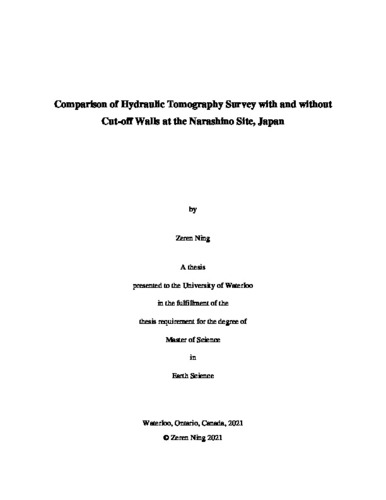| dc.contributor.author | Ning, Zeren | |
| dc.date.accessioned | 2021-01-12 18:43:09 (GMT) | |
| dc.date.available | 2021-01-12 18:43:09 (GMT) | |
| dc.date.issued | 2021-01-12 | |
| dc.date.submitted | 2021-01-07 | |
| dc.identifier.uri | http://hdl.handle.net/10012/16630 | |
| dc.description.abstract | This study investigates the performance of several different conceptualizations of inverse modeling including the effective parameter, geological zonation and geostatistical inversion approaches, on characterizing the hydraulic parameter fields, such as hydraulic conductivity and specific storage, at the Narashino Site in Chiba Prefecture, Japan. The simulation of effective parameter and geological zonation approaches are achieved by coupling HydroGeoSphere (HGS) and model independent parameter estimation code PEST using head records during the step-up pumping/injection tests, while the simulation of geostatistical inversion approach is achieved by using the sequential successive linear estimator with the loop iteration scheme (SSLE_loop) to invert the hydraulic tomography (HT) test data collected during 2019 and 2020. The simulation results of the step-up pumping/injection tests also provide geological information that are used as prior information in the HT analyses.
Results obtained from different approaches suggest that HT is a robust method on characterizing the heterogeneity of hydraulic properties. Comparison of the investigated cases indicates that including more data into the inversion process is able to improve the prediction of the groundwater flow behavior. Yet, a data set that contains noise or error might result in the deterioration of estimation performance. Also, the comparison of results from the 2019 and 2020 HT surveys revealed some discrepancy in the estimated values. The discrepancy might be caused by: (1) different number of tests analyzed; (2) different number of data sets incorporated into the inverse model; (3) different order of tests included in SSLE_loop; and (4) different testing conditions. Overall, this study successfully characterizes the heterogeneity and demonstrates the effectiveness of the HT method at the Narashino Site. | en |
| dc.language.iso | en | en |
| dc.publisher | University of Waterloo | en |
| dc.subject | groundwater modeling | en |
| dc.subject.lcsh | Groundwater flow | en |
| dc.subject.lcsh | Groundwater | en |
| dc.subject.lcsh | Sampling | en |
| dc.subject.lcsh | Quality | en |
| dc.subject.lcsh | Research | en |
| dc.title | Comparison of Hydraulic Tomography Survey with and without Cut-off Walls at the Narashino Site, Japan | en |
| dc.type | Master Thesis | en |
| dc.pending | false | |
| uws-etd.degree.department | Earth and Environmental Sciences | en |
| uws-etd.degree.discipline | Earth Sciences | en |
| uws-etd.degree.grantor | University of Waterloo | en |
| uws-etd.degree | Master of Science | en |
| uws-etd.embargo.terms | 0 | en |
| uws.contributor.advisor | Illman, Walter A. (Walter Arthur) | |
| uws.contributor.affiliation1 | Faculty of Science | en |
| uws.published.city | Waterloo | en |
| uws.published.country | Canada | en |
| uws.published.province | Ontario | en |
| uws.typeOfResource | Text | en |
| uws.peerReviewStatus | Unreviewed | en |
| uws.scholarLevel | Graduate | en |

